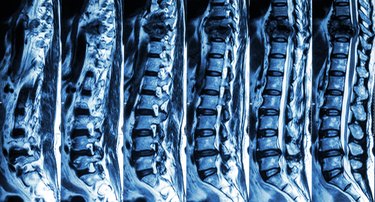
Retrolisthesis is a relatively rare degenerative spinal disc condition that originates in the lower area of the spine. The condition may cause lower back and lower extremity pain in some cases. A variety of pelvic exercises may help relieve and reduce symptoms of retrolisthesis, according to Chiropractic Research Review. The condition causes vertebrae to misalign and place pressure against the vertebral discs, causing pain, difficulty moving and limited range of motion. Physical therapy is often recommended before taking a surgical approach. Learning a few basic exercises to help relieve symptoms may offer benefits.
Manual Physical Therapy
Video of the Day
A professional physical therapist may offer a variety of range of motion exercises for a retrolisthesis patient to perform, according to Spine journal, either in a self-directed or assisted form of exercise. Range of motion exercises for lower back may include stretching, with arms raised above the shoulders or held in front of the chest while patient performs a gentle side to side twisting motion, according to Capital Health.
Video of the Day
Pelvic Tilts
Pelvic tilts offer a low-impact lower back strengthening exercise that is performed lying down. This exercise helps loosen stiff joints and relieve pain caused by a variety of lower-back conditions, such as sciatica and arthritis. The exercise also tightens and strengthens the lower muscles of the abdominal wall and pelvis. Lie on the floor with knees bent. Pull abdomen in toward the floor and slightly rock the top of the pelvis upward. Hold the tilt for about 10 seconds and then relax.
Lower Back Rolls
Lower back rolls may help provide a stretch for the lower back, but talk to your doctor or physical therapist before attempting them. You may not be able to perform this exercise if your retrolisthesis has caused moderate to severe placement of the lower vertebrae. However, the exercise may help relieve pain. Slowly lift knees to the chest and clasp your hands behind your knees, says Capital Health. Slowly, allow your body to roll to the left, then return to starting position. Rest for a moment and then roll to the right.
Hip Rolls
Maintaining strength and support of the pelvis and hip joints is important for those diagnosed with lower spine issues. Do this exercise standing or lying down, depending on your comfort level. Hold onto a chair or wall for balance, with one leg bearing most of your weight, the other knee slightly bent with the ball of the foot touching the floor. Keep the ball of the working foot on the floor and slowly rotate the knee outward, then inward.
Is this an emergency? If you are experiencing serious medical symptoms, please see the National Library of Medicine’s list of signs you need emergency medical attention or call 911.